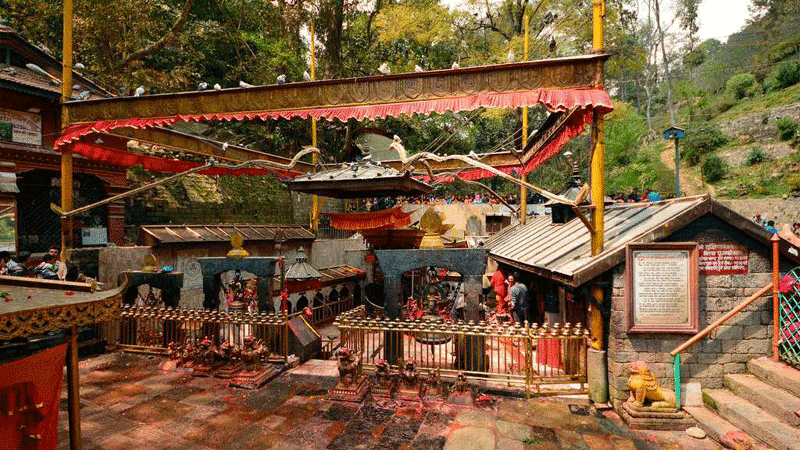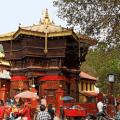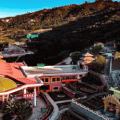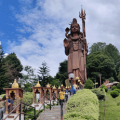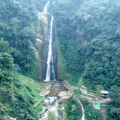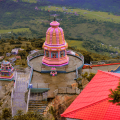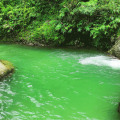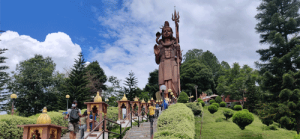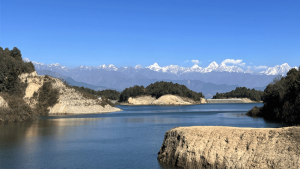Dakshinkali Temple
Dakshinkali Temple is famous by other names as well such as Dakshin Kali Temple or Dakshina Kali Temple. This temple is a significant Hindu temple dedicated to Goddess Kali. There is a belief among Hindus that Goddess Kali is known as the fierce and powerful goddess of creation and destruction. Further, this temple attracts thousands of pilgrims every year. The temple is situated on the bank of a small stream, inside the forests of the southern part of Kathmandu. The temple lies in the village of Pharping which is about 20 km from Ratnapark, Kathmandu. Likewise, the importance of the Dakshinkali temple is special among the Hindu community in Nepal. Hindu pilgrims believe Dakshinkali Devi is an incarnation of Goddess Parvati. Moreover, dense natural forests and green hills surround the holy Dakshinkali Temple.
The statue of the Dakshin Kali in the Dakshinkali Temple is black in color. And then, the statue is presented with Kali’s right foot on the chest of Lord Shiva. But mostly, Goddess Kali is presented with the left foot on the chest of Lord Shiva. Similarly, the statue of Goddess Kali has four hands that symbolize the power of the mother spreading in all four directions (i.e. East, West, North, and South). Moreover, the statue holds the severed head of a human in one hand and a drawn sword in the other hand. However, his two other arms signify the blessings from Goddess Kali to assurance to his devotees of protection. And, this temple is famous for the sacrifice of cockerels, pigeons, and uncastrated male goats.
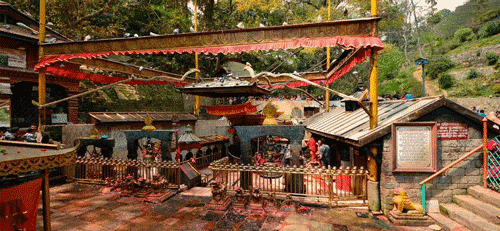
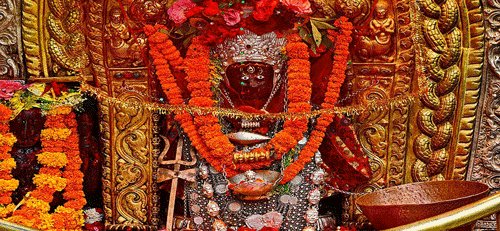
History
Discussing the history of the Dakshinkali Temple dates back to the 18th century. There is a belief that the temple was built by King Pratap Malla of the Malla dynasty. Also, King Pratap Malla ruled over the Kathmandu Valley from 1641 to 1674. According to the myth, the goddess Kali appeared in the dreams of King Malla, and Goddess Kali inspired the King to build the temple in her honor.
There is also a belief that the temple was built in 1855 by Rani Rashmoni. Queen Rashmoni was a devotee of Kali. Over the years, the temple has undergone several renovations, reconstructions, and expansions. Eventually, this temple has become an important landmark in the region.
The Architecture of Dakshinkali Temple
The Dakshinkali Temple is a beautiful example of traditional Nepalese architecture. Also, this temple reflects the traditional Newari style of architecture. Initially, the temple was made of stone and wood. The temple is made of stone, and it has a three-tiered pagoda-style roof. But over the years, the temple has undergone several renovations, expansions, and reconstructions. Lastly, the most recent one took place in 2015 after the devastating earthquake took place in Nepal. A walking courtyard to walk around and offer prayers surround the main temple area. Similarly, there are several smaller shrines and temples within the temple area. Correspondingly, the main shrine or statue dedicates to Goddess Kali which features a large statue of the goddess made of black stone.
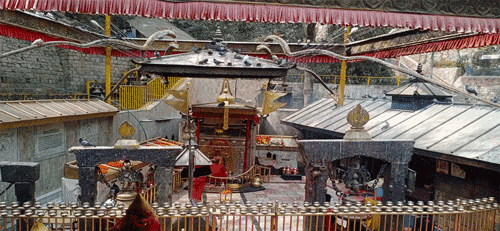

Significance
The Dakshinkali Temple is one of the most important pilgrimage sites for Hindu pilgrims in Nepal. Likewise, the temple is dedicated to Goddess Kali. And Hindu people believe that Goddess Kali is a powerful and fierce goddess of destruction and creation. Also, devotees believe that the Goddess Kali protects devotees from evil spirits and negative energies. Devotees visit the temple to offer their prayers and make offerings to the goddess in the hope of receiving her blessings in return. Correspondingly, there is also a belief among the Hindu community that the one who does not have children can get children by visiting the temple. Moreover, those visitors seek blessings of children by offering or scarifying a black uncastrated male goat in the temple.
Rituals and Offerings at the Temple
The Dakshinkali Temple is famous for its complicated rituals and offerings. Devotees worship the temple and Goddess Kali by offering various items to the goddess, such as flowers, fruits, colors, clothes, coconuts, and incense (agarbatti). Similarly, animal sacrifice is also a common practice at the temple. This sacrifice particularly takes place during the festival of Dashain. During the festival Dashain, thousands of animals are sacrificed at the temple as an offering to the goddess to seek blessings.
Not only animal sacrifice but also several other rituals and ceremonies take place at the temple at different times. One of the most important rituals is the daily puja, temple priests perform the puja each day. The puja involves the reading of prayers or mantras and the offering of various items to the goddess. Also, devotees can perform their puja at the temple, and they can receive blessings from the priests.

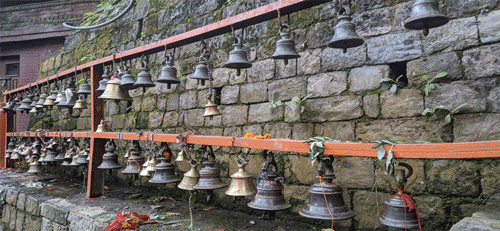
Festivals at Dakshinkali Temple
The Dakshinkali Temple is also famous for its colorful and festive celebrations. One of the most important festivals at the temple is Dashain. In addition, the Dashain Festival is a 15-day-long festival that takes place in September or October. During this festival, thousands of pilgrims visit the temple to offer animal sacrifices to the goddess to seek blessings. Likewise, we can recognize the festival by the playing of music, the singing of hymns, and the lighting of oil lamps which is common among the Hindus.
The other important festival at the temple is Navratri. Navaratri is a nine-day festival that celebrates the victory of good over evil in the Hindu community. During this festival, devotees fast and perform various rituals to honor the goddess in the hope of making the Goddess happy and seeking blessings. The festival ends with the celebration of Dussehra, which we can characterize by the burning of effigies of the demon King Ravana.
Also, the great festival of Hindu women, Haritalika Teej is famous in this temple. This festival is to celebrate and worship Lord Shiva. Hindu women fast at this festival and visit the Dakshin Kali Temple to seek blessings for their husbands. Likewise, we can see women singing and dancing at Teej.
Visiting the Temple
Visitors to Dakshinkali Temple should remove their shoes before entering the main temple. Whereas the temple is open every day from early morning until late evening, and there is no entry fee to visit the temple. Visitors offer prayers and make offerings to the goddess Kali. Similarly, the main prayer hall of the temple is located inside the main temple complex. Likewise, smaller shrines dedicated to various other Hindu deities surround the holy temple. Moreover, there is also a large open space outside the temple where visitors can sit and relax. Animal sacrifices, particularly of cockerels, pigeons, and uncastrated male goats, are the main way of worshipping the goddess Kali, and visitors can especially see them during the Dashain festival.
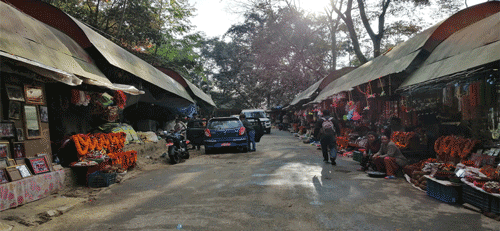
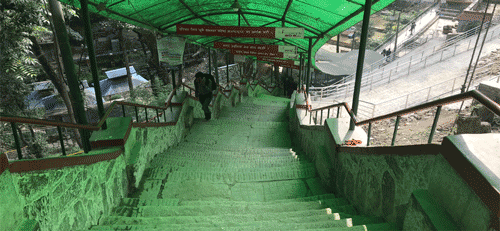
Highlights and Attractions at Dakshinkali
- Dakshinkali Temple
- Traditional Architecture Temple
- Local food (Khuwa)
- Different festivals in the temple area
- Enjoy dense forests and green hills
- Peaceful Environment
You May Also Like To Read About
How to reach Dakshinkali Temple?
Getting a taxi up to Dakshinkali Temple is the easiest way to get there. Besides, public vehicles are also available to get there.
By Private Vehicle or Taxi
Dakshinkali is approximately 20 km away from Ratnapark, Kathmandu. It may take about an hour from Ratnapark to reach the destination in a private vehicle or Taxi.
By Public Vehicle
You can get a public bus from Ratnapark Bus Park to Dakshinkali. It is 20 km away from Ratnapark, Kathmandu. It may take about two hours from Ratnapark to reach the destination in a public vehicle.
Google Map of Dakshinkali Temple
Dakshinkali Temple is a unique and one of the most important Hindu temples located in the southern part of Kathmandu, Nepal. The temple dedicates to Goddess Kali and is famous for its traditional architecture, elaborate rituals, festivals, and its association with several myths. Among the Hindus, Dakshin Kali Temple has the same religious value as the Pashupatinath Temple of Kathmandu and the Manakamana Temple of Gorkha in Nepal. Similarly, the temple has more tourist attractions as it is a popular hiking destination for Shivapuri Hike. There is a belief that she is the benevolent mother, who protects her devotees and children from mishaps and misfortunes and guides them toward the right path.

